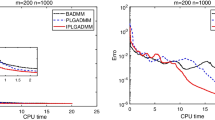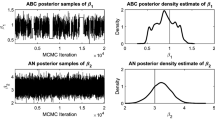Abstract
Higher-order Markov chain plays an important role in analyzing a variety of stochastic processes over time in multi-dimensional spaces. One of the important applications is the study of higher-order PageRank problem. The truncated power method proposed recently provides us with another idea to solve this problem, however, its accuracy and efficiency can be poor in practical computations. In this work, we revisit the higher-order PageRank problem and consider how to solve it efficiently. The contribution of this work is as follows. First, we accelerate the truncated power method for higher-order PageRank. In the improved version, it is neither to form and store the vectors arising from the dangling states, nor to store an auxiliary matrix. Second, we propose a truncated power method with partially updating to further release the overhead, in which one only needs to update some important columns of the approximation in each iteration. However, the truncated power method solves a modified higher-order PageRank model for convenience, which is not mathematically equivalent to the original one. Thus, the third contribution of this work is to propose a sparse power method with partially updating for the original higher-order PageRank problem. The convergence of all the proposed methods are discussed. Numerical experiments on large and sparse real-world and synthetic data sets are performed. Numerical results demonstrate the superiority of our new algorithms over some state-of-the-art ones for large and sparse higher-order PageRank problems.


Similar content being viewed by others
Data availability
Enquiries about data availability should be directed to the authors.
References
Ching, W., Fung, E., Ng, M.K.: Higher-order Markov chain models for categorical data sequences. Naval Res. Logist. 51, 557–574 (2004)
Ching, W., Ng, M.K.: Markov Chains: Models. Springer, Algorithms and Applications (2006)
Ching, W., Ng, M.K., Fung, E.: Higher-oreder multivariate Markov chains and their applications. Linear Algebra Appl. 428, 492–507 (2008)
Chung, K.: Elementary Probability Theory with Stochastic Processes. Springer, New York (1979)
Ciarlet, P.: Linear and Nonlinear Functional Analysis with Applications. SIAM, Philadelphia (2013)
Cipolla, S., Redivo-Zaglia, M., Tudisco, F.: Extrapolation methods for fixed-point Multilinear PageRank computations. Numer. Linear Algebra Appl. 27, e2280 (2020)
Ding, W., Ng, M.K., Wei, Y.: Fast computation of stationary joint probability distribution of sparse Markov chains. Appl. Numer. Math. 125, 68–85 (2018)
Gleich, D.: PageRank beyond the web. SIAM Rev. 57, 321–363 (2015)
Gleich, D., Lim, L., Yu, Y.: Multilinear PageRank. SIAM J. Matrix Anal. Appl. 36, 1507–1541 (2015)
Guo, P.: A residual-based error bound for the multilinear PageRank vector. Linear Multilinear Algebra 68, 568–574 (2020)
Guo, P., Gao, S., Guo, X.: A modified Newton method for multilinear PageRank. Taiwan. J. Math. 22, 1161–1171 (2018)
Huang, J., Wu, G.: Convergence of the fixed-point iteration for multilinear PageRank. Numer. Linear Algebra Appl. 28, e2379 (2021)
Kuntz, J., Thomas, P., Stan, G., Barahona, M.: Stationary distributions of continuous-time Markov chains: a review of theory and truncation-based approximations. SIAM Rev. 63, 3–64 (2021)
Langville, A., Meyer, C.: Google’s PageRank and Beyond: The Science of Search Engine Rankings, Princeton university press, (2006)
Li, W., Liu, D., Ng, M.K., Vong, S.: The uniqueness of multilinear PageRank vectors. Numer. Linear Algebra Appl. 24, e2107 (2017)
Li, W., Liu, D., Vong, S., Xiao, M.: Multilinear PageRank: uniqueness, error bound and perturbation analysis. Appl. Numer. Math. 156, 584–607 (2020)
Li, W., Liu, D., Vong, S.: Perron vector analysis for irreducible nonnegative tensors and its applications. J. Ind. Manag. Optim. 17, 29–50 (2021)
Li, W., Ng, M.K.: On the limiting probability distribution of a transition probability tensor. Linear Multilinear Algebra 62, 362–385 (2014)
Li, X., Ng, M.K.: Solving sparse non-negative tensor equations: algorithms and applications. Front. Math. China 10, 649–680 (2015)
Li, X., Ng, M.K., Ye, Y.: Har: hub, authority and relevance scores in multi-relational data for query search, In: Proceedings of the 2012 SIAM International Conference on Data Mining, (2012), pp. 141–152
Liu, D., Li, W., Vong, S.: Relaxation methods for solving the tensor equation arising from the higher-order Markov chains. Numer. Linear Algebra Appl. 26, e2260 (2019)
Meini, B., Poloni, F.: Perron-based algorithms for the multilinear PageRank. Numer. Linear Algebra Appl. 25, e2177 (2018)
Page, L., Brin, S., Motwani, R., Winograd, T.: The PageRank citation ranking: bringing order to the web, Stanford Digital Libraries Working Paper, (1999)
Raftery, A.: A model for high-order Markov chains. J. R. Statal Soc. 47, 528–539 (1985)
Stewart, W.: Probability, Markov Chains, Queues, and Simulation: The Mathematical Basis of Performance Modeling, Princeton University Press, (2009)
Voorhees, E., Harman, D.: TREC: Experiment and Evaluation in Information Retrieval, vol. 1, MIT Press, (2005)
Wu, G., Wang, Y., Jin, X.: A preconditioned and shifted GMRES algorithm for the PageRank problem with multiple damping factors. SIAM J. Sci. Comput. 34, A2558–A2575 (2012)
Wu, Y., Bian, Y., Zhang, X.: Remember where you came from: on the second-order random walk based proximity measures. Proc. VLDB Endow. 10, 13–24 (2016)
Acknowledgements
We would like to express our sincere thanks to our editor and the anonymous referees for insightful comments and suggestions that greatly improved the representation of this paper.
Funding
Funding was provided by National Natural Science Foundation of China (Grant No. 12271518)
Author information
Authors and Affiliations
Corresponding author
Ethics declarations
Competing interests
There are no conflicts of interest to this work. Our manuscript has no associated data.
Additional information
Publisher's Note
Springer Nature remains neutral with regard to jurisdictional claims in published maps and institutional affiliations.
This work is supported by the National Natural Science Foundation of China under grant 12271518, the Key Research and Development Project of Xuzhou Natural Science Foundation under grant KC22288, and the Open Project of Key Laboratory of Data Science and Intelligence Education of the Ministry of Education under grant DSIE202203.
Appendices
Appendix A: Numerical Results of Subsection 6.2 on Real-World Data Set
Appendix B: Numerical Results of Subsection 6.3 on Synthetic Data Set
Rights and permissions
Springer Nature or its licensor (e.g. a society or other partner) holds exclusive rights to this article under a publishing agreement with the author(s) or other rightsholder(s); author self-archiving of the accepted manuscript version of this article is solely governed by the terms of such publishing agreement and applicable law.
About this article
Cite this article
Huang, J., Wu, G. Truncated and Sparse Power Methods with Partially Updating for Large and Sparse Higher-Order PageRank Problems. J Sci Comput 95, 34 (2023). https://doi.org/10.1007/s10915-023-02146-0
Received:
Revised:
Accepted:
Published:
DOI: https://doi.org/10.1007/s10915-023-02146-0
Keywords
- Higher-order Markov chain
- Higher-order PageRank
- Multilinear PageRank
- Truncated power method
- Partially updating strategy




